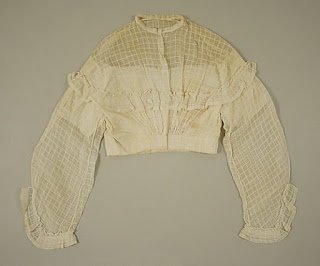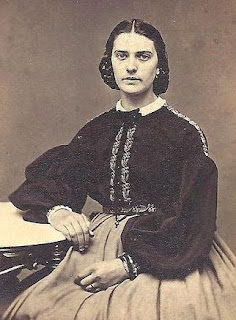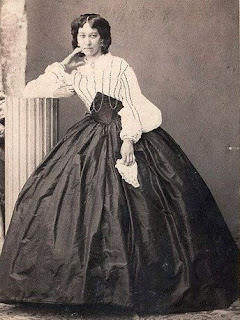Then you get on a reenactor online forum and you see this discussion about "the dreaded skirt and blouse combo." You read it and you're in the dumps - apparently the mismatched skirt and blouse are ALL WRONG and were never worn during the war. You sadly consider the cost of buying an entirely new outfit.
But THEN you start looking on Pinterest at original photos of Civil War ladies. WAIT! There are ladies in real 1860s photographs wearing a skirt and blouse!
Okayyyyy, what's going on here?
 |
| US National Archives 111-B-1686 |
The first item to consider is whether Civil War ladies only wore outfits with matching skirt and top, or if they wore mis-matched outfits too. The answer is, they wore both. Sort of.
The mainstay of all female wardrobes in the 1860s was the matched skirt and bodice. Sometimes it was a one-piece dress, sometimes the pieces were separate, allowing for two different styles of matching bodice to be worn (a day bodice and an evening bodice, for example). If you looked in any woman's closet, the majority of what you'd find would be dresses with matching skirt and top.
 |
| Barrington House photo. 1860s. |
And that's where fashion historians blow a gasket, because the modern sutler version of a white blouse and calico skirt doesn't even come close to fitting the 1860s parameters for what we now call a "skirt and blouse."
So let's take a look at what these outfits really looked like.
 |
| Musées Nationaux-Grand Palais |
A "blouse" was originally a man's garment. Using the term "blouse" for woman's clothing is still a fairly new thing in this era, and it refers to a certain kind of top, one that imitates a gentleman's shirt. Up till now, we have been calling a ladies' top a "bodice," a "waist," or a "body." These terms could mean slightly different things depending on your region.
What we call the "blouse" of the 1860s (and I will use this term the rest of this post because it's familiar) was almost always white and almost always very fine, beautiful fabric. Sheer cottons, silks and wools were often used. Tucks, frills, and furbelows of all sorts were generally included. Many times we see ribbon woven into the collar, or even into the whole blouse. It was a sharp looking, well-fitting, high fashion garment.
Here is a blouse from the Met Museum made from sheer window-pane fine cotton. It is partially lined and includes a fitted waistband and some lovely ruffles.
This gorgeous sheer blouse (it appears to be silk) is puffed to kingdom come! A fitted waistband and frilly collar complete this little piece of elegance.
And just one more example (someone please stop me!). This one is so pretty with its detailed white-work flowers. It's likely that white-work was done by hand.
The Garibaldi Blouse
As I said, blouses were almost always white. The exception was for an outfit mimicking the famous Guiseppe Garibaldi, a freedom fighter in Italy. Garibaldi blouses worn by ladies were generally red, like his was, and included intricate, military-style black trim. You'll often see mock epaulettes on the shoulders. These gorgeous blouses were usually made of fine wool or silk. Because they were solid colored, they were almost never made of cotton - solid cottons were very rare in the 1860s.
 |
| Lovely - but not for Civil War era! |
So even though those lovely flowing white blouses on sutler row look so enticing, they're not accurate. The cotton fabric is usually too coarse and heavy, the blouse is too loose and floppy, there is almost never a proper collar - and I'm just getting started! Basically, a ready-made blouse of any kind will probably not look right for our era. Blouses of the 1860s were made to fit YOU and you only.
 |
| Conversation Piece, Lilly Martin Spencer |
So now we come to the second part of the ensemble. Remember that a "skirt and blouse" combo is considered a high fashion outfit. The cheap floppy calico skirts on sutler row don't make the cut.
Skirts of the 1860s were generally fine tightly woven silk or wool. Both solids and patterns were used - but watch out which patterns you choose! Some of our modern designs simply weren't around back then. Plaids and stripes are generally pretty safe (and if you're concerned about a plaid, you can research it online to see when it was created).
 |
| 1864 Ladies Friend Magazine |
The Belt
Now we come to the optional finishing touch. A belt is not necessary for this ensemble, but it does make a nice statement and was quite popular. Here are some types of belts that were worn with these outfits:
- Velvet or silk with rectangular metal buckle (like the fashion plate above)
- Velvet or silk with double buckle
- Rosette belt (came into fashion in the mid-1860s)
- Medici belt - these were generally silk, fitted your waist (no bow in the back, a la sutler row) and sometimes beautifully embroidered
- Swiss waist - a silk, corset-like garment
So if you're a young lady, or if you're portraying a fashion-forward lady, a skirt and blouse ensemble may be for you. But save yourself some money by avoiding sutler row and instead go for the stunning original design: a high-quality finely designed blouse and silk or wool skirt.
This young woman shows off the perfect ensemble: Frilly sheer blouse with ribbon woven in, silk medici belt and silk taffeta skirt. Her hair is smoothly in order and her lacy hankie provides the perfect finishing touch.
Here's another photo from my sister's collection. Though mother and daughter's faces look almost alike, mama has a fashionable but predictable lady's outfit, probably a one-piece dress with lovely trim. Daughter, on the other hand, is more fashion-forward and is wearing a beautifully trimmed Garibaldi blouse - she probably sewed all that trim on herself! Her dark solid skirt is likely black silk. Both she and mama complete their ensembles with neck bows and ribbon hairnets. Such a lovely couple!
If you want to see more gorgeous blouse outfits from the 1860s, check out my Pinterest board on the subject.
This outfit was so fun that sis and I decided to attempt it ourselves. We found some lovely sheer cotton and sis made our gorgeous blouses with plenty of tucks and frills. I made the skirts - mine is swishy silk taffeta and sis's is a rich wool. I also made our cockades. And Mom made our snazzy hairnets! I think the whole effect turned out nicely!









Nice article. ..thanks!
ReplyDeleteHi, You might be interested in some of the research I've done on the Garibaldi Blouse. The picture you have isn't one of the Garibaldi blouses -the term is way too often misused in the re-enactor circles. I believe it's a colored spencer instead.
ReplyDelete